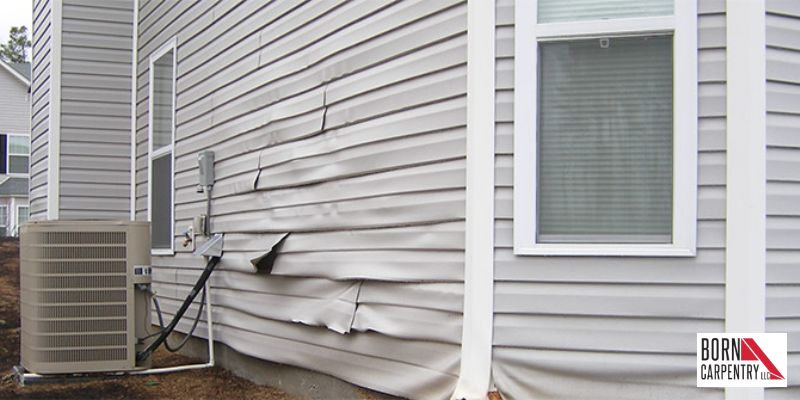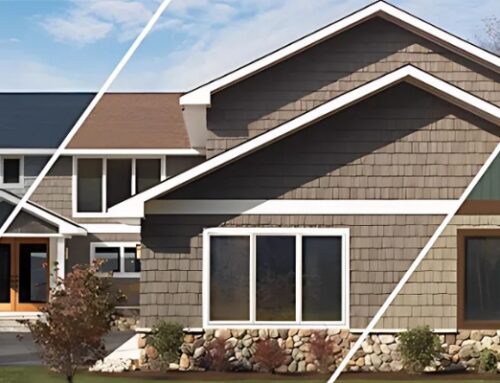Siding is a crucial element in enhancing the beauty, durability and energy efficiency of your home’s exterior. It not only protects your home from external elements such as sunlight, rain, wind and snow but also adds value and curb appeal to your property. However, like any other part of your home, siding can face several problems that can affect its performance and appearance. These problems can range from minor issues like fading and discoloration to more severe ones like cracks, leaks and rot. As a homeowner, it’s essential to identify these common siding problems so that you can tackle them effectively and prevent further damage.
What are some common siding struggles you might encounter? Here’s what to look for…
#1 Cracking Or Warping:

Siding can crack or warp due to changes in temperature, exposure to moisture or poor installation. To tackle this problem, it’s important to inspect your siding regularly for signs of damage. If you notice any cracks or warping, it’s best to address the issue right away before it leads to more significant problems.
If the damage is minor, you might be able to repair it yourself with some caulk or paint. However, if the damage is severe, you may need to replace the affected section of the siding or hire a professional to do so. It’s also important to ensure that your siding is installed properly to prevent cracking or warping in the future.
#2 Mold Or Mildew Growth:

Mold and mildew can grow on siding, especially in areas with high humidity or moisture. This can not only be unsightly but also potentially harmful to your health. To tackle this problem, it’s important to clean your siding regularly, especially in areas where moisture tends to accumulate.
You can use a solution of water and bleach or a specialized cleaning product to remove mold and mildew from your siding. Be sure to wear gloves and eye protection, and follow the manufacturer’s instructions carefully. If you have a large area of mold or mildew growth, you may need to hire a professional to clean your siding or even replace it if the damage is extensive. Additionally, taking steps to improve ventilation around your home and reducing moisture levels can help prevent mold and mildew growth in the future.
#3 Fading Or Discoloration:
Siding can fade or become discolored over time due to exposure to the sun’s UV rays, environmental pollutants or improper cleaning techniques. To tackle this problem, you can try cleaning your siding with a mild detergent and a soft-bristled brush. Avoid using harsh chemicals or abrasive materials that can damage the siding’s surface.
If your siding is severely faded or discolored, you may need to consider re-painting or replacing it. Before painting, be sure to clean and prepare the surface properly, and use a high-quality paint designed for use on siding. If you decide to replace your siding, consider choosing a product with a fade-resistant finish to prevent future discoloration.
#4 Insect Or Pest Infestation:
Siding can also be susceptible to insect or pest infestations, such as termites, ants or rodents. To tackle this problem, it’s important to inspect your siding regularly for signs of damage, such as holes or tunnels. You can also seal any gaps or cracks in your siding with caulk or foam insulation to prevent pests from entering.
If you suspect an infestation, it’s best to contact a pest control professional who can identify the type of pest and recommend the best course of action. In some cases, you may need to replace the affected section of siding to remove the source of the infestation. Additionally, taking steps to reduce moisture levels around your home and storing firewood and other materials away from your siding can help prevent future pest problems.
#5 Leaks:
Leaks can occur around windows, doors or other areas where siding meets another surface, such as a roof or chimney. To tackle this problem, you can inspect your siding regularly for signs of water damage or moisture, such as discoloration, rot or mold growth. You can also check for gaps or cracks in your siding, and seal them with caulk or foam insulation.
If you suspect a leak, it’s important to locate the source of the problem and address it promptly. This may involve removing a section of siding or hiring a professional to do so. Additionally, taking steps to improve ventilation around your home, such as installing a dehumidifier or exhaust fan, can help reduce moisture levels and prevent future leaks.
#6 Hail Damage:
Hail can cause significant damage to siding, including dents, cracks or holes. To tackle this problem, you can inspect your siding after a hailstorm for signs of damage. If you notice any dents or other damage, you can contact your insurance company to file a claim and request an inspection.
If the damage is minor, you may be able to repair it yourself with some putty or sealant. However, if the damage is severe, you may need to replace the affected section of the siding or even your entire siding. It’s important to hire a qualified professional to do the repairs or replacement to ensure that your siding is installed properly and will protect your home from future hail damage. Additionally, consider choosing a siding material that is more resistant to hail damage, such as fiber cement or metal.
Summary:
In conclusion, siding plays an essential role in protecting your home from external elements, and any problems with it should be dealt with immediately. By identifying the common siding issues highlighted in this blog post, you can take the necessary steps to prevent further damage and maintain the appearance and functionality of your home’s exterior. Remember to regularly inspect your siding, clean it and address any issues promptly to ensure it remains in top condition for years to come.






